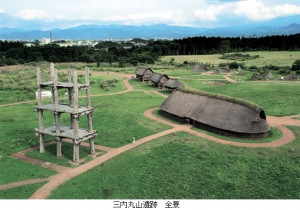Jomon civilization (4) 2014/12/15
Nearly 100,000 ruins of Jomon period ( around 15,000 years ago to 3,000 years ago) have been excavated in Japan. Thick density of ruins indicates the density of population in the Japanese archipelago at that time, especially in eastern part of Japan, was presumably the highest in the whole world.
The thick density of the population probably accelerated the progress of the civilization. Sannai Maruyama site which is the ruin of mid Jomon period revealed the continuous occupation of the site from around 5,500 years ago to 4,000 years ago. The ruin showed us the highly sophisticated community there as under.
Alongside of the main street, there were well organized pit dwellings, graves and a garbage dump with the huge monument at the center.
There were apparently different two types of graves which indicated the prevalence of the scientific theory of avoiding incest. From the monument, we can learn they had high level of understanding about the astronomy and they knew the summer solstice together with the winter solstice and so on.
Contrary to the prevailing historical viewpoint, around 5% of graves had extraordinary giant sizes which indicated there were already some kind of classification existed.
Judging from the size, a pit dwelling could contain 5 to 10 humans which indicated each family lived together in each dwelling. At the center of the each dwelling, there was a fireplace not for cooking but probably for praying. At the deep corner, there was something like the altar, presumably also for praying. Jomon people kept praying for their ancestors and the something great in the nature.
Around a settlement there was an intermediate area between great nature and a man-made settlement. In an intermediate area , people could obtain various natural or cultivated foods like nuts or greens or daily necessities like materials for tools or fire woods. By developing a settlement together with an intermediate area, people could improve the quality of settled life style and learn how to keep sustainable circulation.
People kept appreciating for the ample natural blessings and established the life style of living together with nature.
 reconstructed Sannai Maruyama ruin
reconstructed Sannai Maruyama ruin







